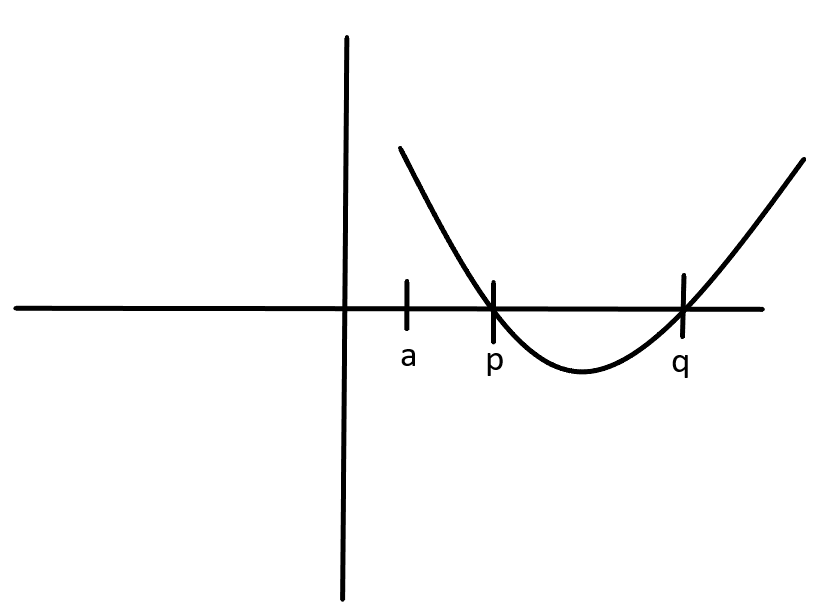
If the roots of ${x^2} + x + a = 0$ exceed $a$, then
A. $2 < a < 3$
B. $a > 3$
C. $ - 3 < a < 3$
D. $a < - 2$
Answer
217.2k+ views
Hint: Check the concavity of the given quadratic equation and using this information check whether $f(a)$ is positive or negative. Also use the fact that the discriminant must be greater than 0 as real roots exist. With the two inequalities, find the range of a.
Formula used: Discriminant of the standard quadratic equation $a{x^2} + bx + c = 0$ is ${b^2} - 4ac$
Complete step-by-step solution:
Let $f(x) = {x^2} + x + a$
The coefficient of ${x^2}$ in the equation ${x^2} + x + a = 0$ is greater than 0. Therefore, it is a concave upwards graph. Since it is a concave upwards graph, $f(x)$ will be negative only when $x \in \left[ {p,q} \right]$ where $p,q$ are the roots.

Therefore, $f(a)$ is positive. We also know that real roots exist. Therefore, the discriminant of the quadratic equation, ${x^2} + x + a = 0$ must also be greater than 0.
Since $f(a) > 0$,
${a^2} + a + a > 0$
${a^2} + 2a > 0$
$a(a + 2) > 0$
$a \in \left( { - \infty , - 2} \right) \cup \left( {0,\infty } \right)$
Since discriminant, $D > 0$,
$1 - 4a > 0$
$4a < 1$
$a < \dfrac{1}{4}$
$a \in \left( { - \infty ,\dfrac{1}{4}} \right)$
Taking the intersection of $\left( { - \infty , - 2} \right) \cup \left( {0,\infty } \right)$ and \[\left( { - \infty ,\dfrac{1}{4}} \right)\] we get $a \in \left( { - \infty , - 2} \right)$.
Therefore, the correct answer is option D. $a < - 2$.
Note: Given a quadratic polynomial $a{x^2} + bx + c$, if $a > 0$ then the graph of the quadratic polynomial will be a concave upwards graph and if $a < 0$ then the graph of the quadratic polynomial will be a concave downwards graph.
Formula used: Discriminant of the standard quadratic equation $a{x^2} + bx + c = 0$ is ${b^2} - 4ac$
Complete step-by-step solution:
Let $f(x) = {x^2} + x + a$
The coefficient of ${x^2}$ in the equation ${x^2} + x + a = 0$ is greater than 0. Therefore, it is a concave upwards graph. Since it is a concave upwards graph, $f(x)$ will be negative only when $x \in \left[ {p,q} \right]$ where $p,q$ are the roots.

Therefore, $f(a)$ is positive. We also know that real roots exist. Therefore, the discriminant of the quadratic equation, ${x^2} + x + a = 0$ must also be greater than 0.
Since $f(a) > 0$,
${a^2} + a + a > 0$
${a^2} + 2a > 0$
$a(a + 2) > 0$
$a \in \left( { - \infty , - 2} \right) \cup \left( {0,\infty } \right)$
Since discriminant, $D > 0$,
$1 - 4a > 0$
$4a < 1$
$a < \dfrac{1}{4}$
$a \in \left( { - \infty ,\dfrac{1}{4}} \right)$
Taking the intersection of $\left( { - \infty , - 2} \right) \cup \left( {0,\infty } \right)$ and \[\left( { - \infty ,\dfrac{1}{4}} \right)\] we get $a \in \left( { - \infty , - 2} \right)$.
Therefore, the correct answer is option D. $a < - 2$.
Note: Given a quadratic polynomial $a{x^2} + bx + c$, if $a > 0$ then the graph of the quadratic polynomial will be a concave upwards graph and if $a < 0$ then the graph of the quadratic polynomial will be a concave downwards graph.
Recently Updated Pages
Area vs Volume: Key Differences Explained for Students

Mutually Exclusive vs Independent Events: Key Differences Explained

Spring Force Explained: Formula, Unit & Everyday Examples

Spring Force & Hooke's Law Explained with Easy Examples

Static and Kinetic Friction Explained: Definitions & Examples

Static Friction Explained: Definition, Formula & Examples

Trending doubts
JEE Main 2026: Application Form Open, Exam Dates, Syllabus, Eligibility & Question Papers

JEE Main 2026 Chapter-Wise Syllabus for Physics, Chemistry and Maths – Download PDF

JEE Main Previous Year Question Paper with Answer Keys and Solutions

Understanding Newton’s Laws of Motion

JEE Main Cut Off 2026 - Expected Qualifying Marks and Percentile Category Wise

Marks vs Percentile JEE Mains 2026: Calculate Percentile Marks

Other Pages
NCERT Solutions For Class 10 Maths Chapter 12 Surface Area And Volume

NCERT Solutions for Class 10 Maths Chapter Chapter 13 Statistics

NCERT Solutions for Class 10 Maths Chapter 11 Areas Related to Circles 2025-26

Pregnancy Week and Due Date Calculator: Find How Far Along You Are

NCERT Solutions for Class 10 Maths Chapter 15 Probability

Complete List of Class 10 Maths Formulas (Chapterwise)




